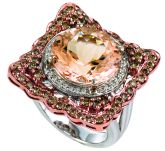Prestige by Association: Celebrity Ambassadors
February 03, 08
Celebrities – stars of the silver screen, television sitcoms and hip hop labels included – are everywhere you look, and they’re there for a reason. Stars in advertisements, on paper, in print and on the screen, are used by marketers as part of a carefully calculated product placement campaign, to sell anything from mayonaise to luxury sedans.
Celebrities fill one of two marketing roles – either as a spokesperson or as an added interest factor for the product. In the case of the former, they are legally contracted as a brand representative to be the physical and easily recognizable face of the product. The latter often takes place through various one-off events, which can include anything from having the star wear the firm’s jewelry on the red carpet to having them appear at a PR event promoting the company.
So why turn to a famous face and name for getting the product’s message across? Those in the business of public relations hope that some of the magic of the celebrity will rub off on the firm and boost sales, simply due to the star’s presence and their association with the company. Through this partnership, be it a formal contract or a one-off appearance, they attempt to capitalize on the public’s affection for, or fascination with, the stars to turn it into an interest for the product.
James Grant, founder of Starworks New York – a marketing company that works with celebrities and whose contracts have included Uma Thurman for Louis Vuitton, Angelina Jolie for St. John and Lindsay Lohan for Miu Miu – says that when it comes to such endorsements, image and sales should be a company’s first priorities. Keeping these goals clearly in mind makes it easy to decide whether or not a certain persona is the right fit for the brand.
He maintains that companies must first cement their product message and campaign vision before choosing their A-list representative and stresses that it’s not always the obvious choices that work the best. “Sometimes even a campaign that seems like a total mismatch with a celebrity, ones where you never would have thought of that combination, can work,” he says. “A truly great match is one that increases sales for the brand and is lasting. If you don’t see a spike in sales and a steady climb from there, it’s not the right collaboration.
”When it comes to what celebs are and are not required to do for the product they are advertising, it all boils down to their individual contracts. The core of most ambassadors’ work will revolve around the company’s visual advertising campaign, which, as Grant says, is the vehicle that establishes the brand’s identity.
He also notes that a successful ambassador agreement will utilize a substantial PR element, which could include clauses necessitating that the celebrity either wears or uses the product they represent in their daily life, as well as publicly and for certain promotional events. In addition, they are also often obliged to make appearances at a certain number of the client’s functions throughout the contract period.
To develop a successful partnership between a product and a celebrity, Grant says that the key is building a relationship that is lasting and organic and that sends a positive message to the consumer of mutual commitment between the celebrity and the brand.
Cynthia Hornig and Jennifer Jones are the managing partners and co-founders of Outhouse PR in New York. This boutique PR and event marketing firm specializes in grassroots brand building and image proliferation for emerging and high profile luxury companies. They assert that using a famous person around the company’s visual advertising campaign, which, as Grant says, is the vehicle that establishes the brand’s identity has a marked impact on the visibility of the firm. “Brands look for associations with celebrities who inspire a following. Putting a face to the product brings a lifestyle context to the brand which can influence consumer perception.”
However, regarding the tangible benefits of celebrity connections, they caution that there is no hard and fast way of measuring the results. “Whether increased visibility and enhanced brand definition through celebrity associations translates into sales would have to be examined on a case-by-case basis,” they say.
Many jewelry firms, who might previously have been content to let their products speak for themselves, are increasingly turning to stars to boost their brands. When it came to launching their Caressa line of jewelry in May 2007, Taché Diamonds, an Antwerp-based DTC Sightholder, secured the services of daytime TV star Leven Rambin, who stars in the long-running daytime TV soap opera All My Children.
|
|
The star has a two-year contract to appear in Caressa’s national ad campaign and showcase the jewelry at various PR events for the company. She is also obligated to represent the line at 75 percent of her red carpet appearances.
The firm says that Rambin was chosen over other candidates because of what she represents as a young (she’s only 17), successful (she has already been nominated for two Daytime Emmy Awards) and stylish actress. Kendra Bridel Weinman, executive vice president of Caressa Jewelry, says that the target market of the line is “strong and determined women who also represent style and grace,” qualities that they see in Rambin.
The company insists that it has been a fruitful partnership. “It has definitely helped in terms of visibility. We are now represented at weekly entertainment industry events and on the red carpet,” Bridel Weinman says.
One company that has opted for “celebrities” of another sort is luxury writing instrument firm Montblanc, which has also forayed into the watch and jewelry arenas. While they may not be household names, to a certain demographic, Hélène Grimaud, a classical pianist and Katherine Jenkins, a mezzo-soprano opera star, are absolute A-listers.
As the company explains, through numerous partnerships and sponsorships Montblanc is closely linked to the world of arts and culture. Therefore, it made perfect sense for the company to choose brand ambassadors from this stratum of society rather than going for Hollywood icons. The choice is perfectly in line with how the company hopes to market itself – as a luxury, high-end brand – and with its desire to differentiate its product from the mass market.
Jenkins and Grimaud both represent Montblanc internationally. They participate in store openings and the company’s print campaigns. In addition, Montblanc sponsored Jenkins’ latest UK tour, emphasizing that the company not only profits from the arts, but also supports them.
Sometimes, however, when it comes to endorsements, there’s nothing like a beautiful, well-known face to really do a product justice, which is why Italian watch firm Breil Milano has contracted Hollywood actress Charlize Theron as the face of its collection. The South African-born Theron now stars in all of the firm’s advertising campaigns, which includes television, press, cinema and outdoor advertisements.
There is, of course, a danger in relying on a well-known to put across the image a company wants to represent. Any bad behavior by the celeb will ultimately be reflected on the brand. However, Breil Mi lano says one of the reasons that they chose the Academy Award winner is because of her ability to stay out of the gossip columns. Maintaining this aura of being “above all that” is seen as one of her most attractive traits. Furthermore Theron's sophistication, sexiness, beauty, modern femininity and dedication to social responsibility are meant to embody what Breil Milano wants its customers to see as the qualities of its watches.
Theron actually has a dual role for the watch firm. Not only is she their brand ambassador, but she was also chosen to personify a new female target audience that the company wants to reach. The actress both embodies the qualities of the brand, and is meant to be a typecast for the consumer.
The level of success a celebrity adds to a company is based on many factors. However, the experts agree that adding a high-profile spokesperson to an ad campaign certainly adds visibility, which has the very real possibility of increasing sales and strengthening the product.
